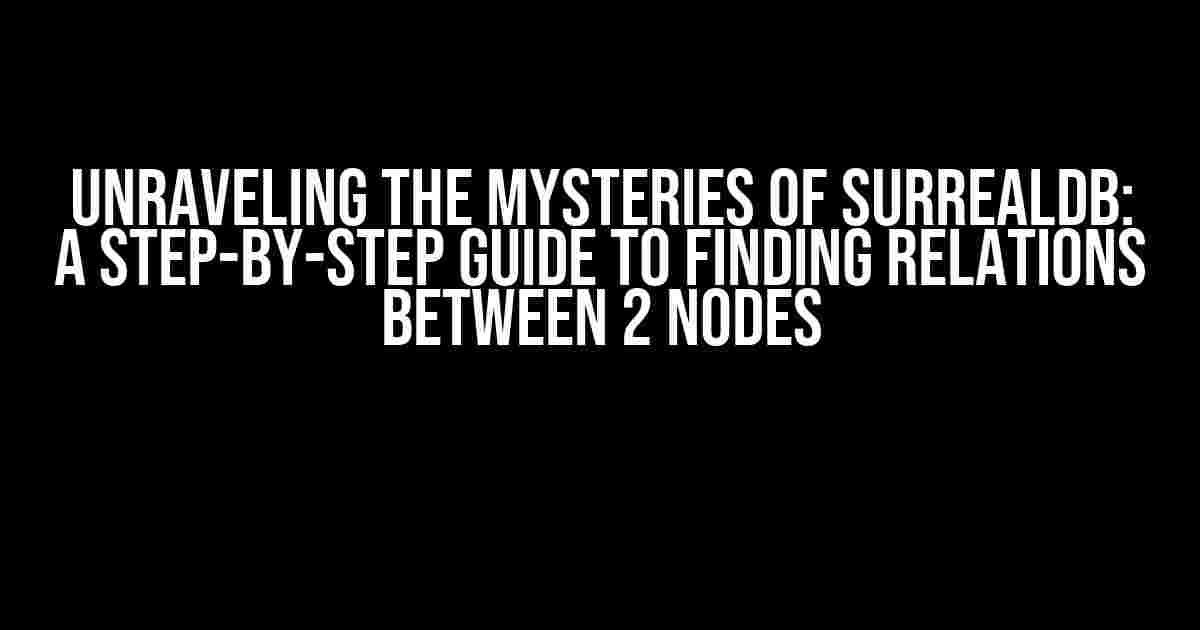Are you tired of sifting through endless lines of code, searching for that elusive connection between two nodes in your SurrealDB database? Do you find yourself stuck, wondering how to uncover the hidden relationships that bind your data together? Fear not, dear reader, for we’ve got you covered! In this comprehensive guide, we’ll delve into the world of SurrealDB and reveal the secrets to finding those pesky relations between two nodes.
- The Quest Begins: Understanding SurrealDB and Its Architecture
- Gathering Tools and Resources
- Step 1: Identify the Nodes and Their Properties
- Step 2: Explore the Neighborhood
- Step 3: Analyze the Relations
- Step 4: Visualize the Relations
- Step 5: Write a Query to Retrieve the Relations
- Conclusion
- Bonus Tips and Tricks
The Quest Begins: Understanding SurrealDB and Its Architecture
Before we dive headfirst into the fray, it’s essential to grasp the fundamental concepts of SurrealDB and its underlying architecture. SurrealDB is a graph database, which means it’s designed to store and query complex, interconnected data structures. It’s built on top of a unique architecture that enables lightning-fast query execution and scalability.
Key Concepts: Nodes, Edges, and Relations
In SurrealDB, data is represented as nodes and edges. Nodes are the individual entities, such as users, products, or locations, while edges represent the connections between them. These edges can be thought of as relationships, which can be one-to-one, one-to-many, or many-to-many.
Relations, in the context of SurrealDB, refer to the connections between nodes. These relations can be explicit, such as a user liking a product, or implicit, like a product being part of a specific category. Understanding these relations is crucial for querying and manipulating data in SurrealDB.
Gathering Tools and Resources
Before we start our journey, make sure you have the following tools and resources at your disposal:
- A SurrealDB instance up and running
- A basic understanding of SQL and graph databases
- A preferred programming language (e.g., Python, JavaScript, or Ruby)
- A SurrealDB driver or SDK for your chosen language
Step 1: Identify the Nodes and Their Properties
The first step in finding relations between two nodes is to identify the nodes themselves and their properties. Let’s assume we have two nodes: `Node A` and `Node B`. We’ll use the `info` command to retrieve their properties.
curl -X POST \
http://localhost:8000/rpc \
-H 'Content-Type: application/json' \
-d '{
"method": "info",
"params": ["Node A", "Node B"],
"id": 1
}'
This will return a JSON response containing the properties of `Node A` and `Node B`. Take note of the `id`, `label`, and `properties` fields, as we’ll use them later.
Step 2: Explore the Neighborhood
Now that we have the node properties, let’s explore their neighborhood. We’ll use the `neighbors` command to retrieve the adjacent nodes and their relationships.
curl -X POST \
http://localhost:8000/rpc \
-H 'Content-Type: application/json' \
-d '{
"method": "neighbors",
"params": ["Node A", "any"],
"id": 2
}'
This will return a list of nodes connected to `Node A`, along with their relationship types and directions. Repeat this process for `Node B` to get a comprehensive view of their neighborhoods.
Step 3: Analyze the Relations
With the neighborhood data in hand, it’s time to analyze the relations between `Node A` and `Node B`. We’ll use the `relations` command to retrieve the relationships between the two nodes.
curl -X POST \
http://localhost:8000/rpc \
-H 'Content-Type: application/json' \
-d '{
"method": "relations",
"params": ["Node A", "Node B"],
"id": 3
}'
This will return a list of relations between `Node A` and `Node B`, including the relationship type, direction, and properties. Take note of the `relation` field, which contains the relationship type and direction.
Step 4: Visualize the Relations
To better understand the relations between `Node A` and `Node B`, let’s visualize them using a graph visualization tool like Gephi or NetworkX. This will help us identify patterns and connections that might not be immediately apparent.
| Node A | Node B | Relation |
|---|---|---|
| User | Product | LIKES |
| User | Category | PART_OF |
| Product | Category |
Step 5: Write a Query to Retrieve the Relations
Now that we’ve identified and visualized the relations, it’s time to write a query to retrieve them. We’ll use the SurrealDB query language to craft a query that retrieves the relations between `Node A` and `Node B`.
MATCH (a:Node A)-[r]->(b:Node B)
RETURN r
This query uses the `MATCH` clause to find the relations between `Node A` and `Node B`, and the `RETURN` clause to retrieve the relations themselves.
Conclusion
And there you have it, folks! With these steps, you should now be able to find the relations between two nodes in your SurrealDB database. Remember to explore your data, analyze the relations, and visualize the connections to uncover hidden patterns and insights.
As you continue to master SurrealDB, remember that the key to unlocking its full potential lies in understanding the relationships between nodes. By following these steps and practicing your skills, you’ll become a SurrealDB ninja, effortlessly navigating the complexities of your graph database.
Bonus Tips and Tricks
- Use the `WITH` clause to optimize your queries and reduce the amount of data transferred between nodes.
- Utilize the `OPTIONAL MATCH` clause to handle optional relationships and avoid null values.
- Experiment with different visualization tools to find the one that best suits your needs.
- Don’t be afraid to ask for help when you’re stuck – the SurrealDB community is always eager to lend a hand.
Happy querying, and may the relations be ever in your favor!
Frequently Asked Question
SurrealDB is a powerful graph database that allows you to store and query complex relationships between nodes. But, have you ever wondered how to find what relations exist between two nodes in SurrealDB? Well, wonder no more! Here are the answers to your burning questions:
How do I query relationships between two nodes in SurrealDB?
You can use the `MATCH` clause in SurrealDB to query relationships between two nodes. For example, `MATCH (n1:Node {id: 1})-[:RELATIONSHIP]-(n2:Node {id: 2}) RETURN *` would return all relationships between node 1 and node 2. Replace `:RELATIONSHIP` with the actual relationship type you’re interested in.
What if I don’t know the exact relationship type between the two nodes?
No worries! You can use the `MATCH` clause with a wildcard character `*` to match any relationship type. For example, `MATCH (n1:Node {id: 1})-[*]-(n2:Node {id: 2}) RETURN *` would return all relationships between node 1 and node 2, regardless of the relationship type.
Can I filter the relationships based on specific properties or conditions?
Yes, you can! Use the `WHERE` clause to filter the relationships based on specific properties or conditions. For example, `MATCH (n1:Node {id: 1})-[:RELATIONSHIP]-(n2:Node {id: 2}) WHERE n1.property = ‘value’ AND n2.property = ‘value’ RETURN *` would return only the relationships between node 1 and node 2 that match the specified property values.
What if I want to retrieve only the relationship objects, not the entire nodes?
You can use the `MATCH` clause with the `RETURN` clause to retrieve only the relationship objects. For example, `MATCH (n1:Node {id: 1})-[:RELATIONSHIP]-(n2:Node {id: 2}) RETURN :RELATIONSHIP` would return only the relationship objects between node 1 and node 2.
Can I use aggregation functions to group or count relationships between nodes?
Yes, you can! SurrealDB supports aggregation functions like `COUNT`, `SUM`, `AVG`, and more. For example, `MATCH (n1:Node {id: 1})-[:RELATIONSHIP]-(n2:Node {id: 2}) RETURN COUNT(:RELATIONSHIP)` would return the count of relationships between node 1 and node 2.


